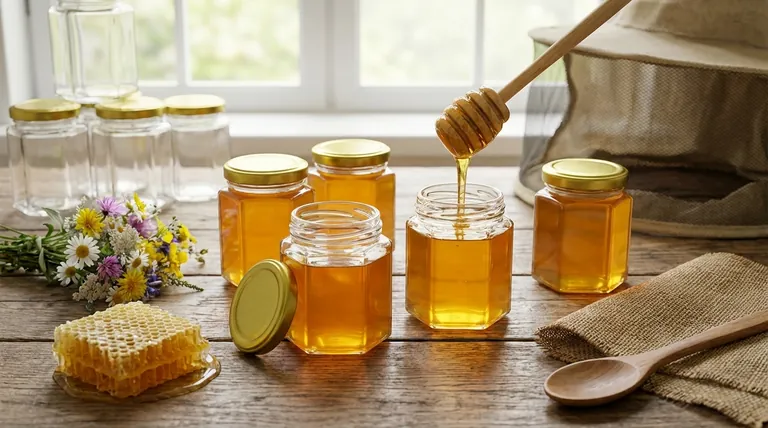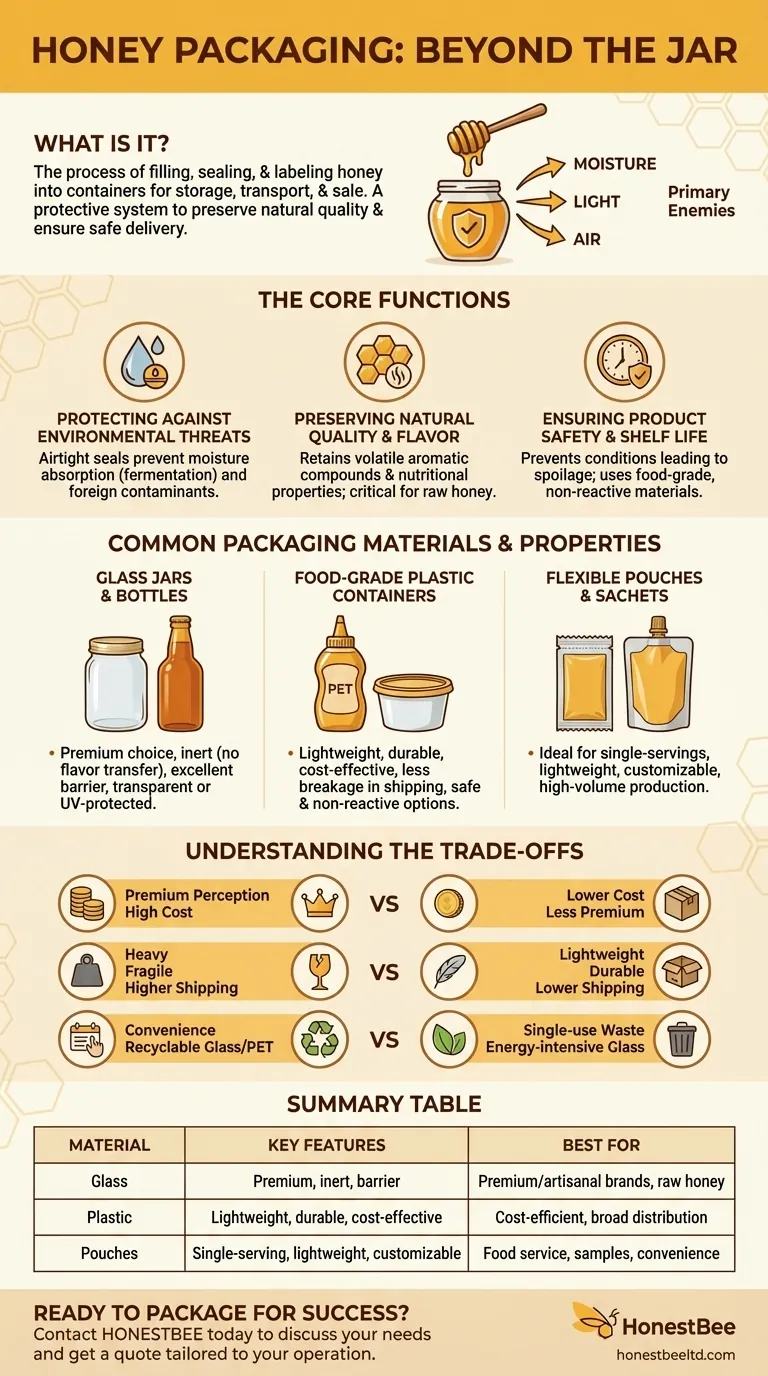At its core, honey packaging is the process of filling, sealing, and labeling honey into containers for storage, transport, and sale. It is a critical step that uses specific materials and machinery to protect honey from environmental damage, preserve its natural quality, and ensure it reaches the customer safely and in an appealing form.
Honey packaging is more than just putting honey in a jar. It is a protective system designed to defend honey against its primary enemies—moisture, light, and air—thereby preserving its flavor, aroma, and shelf life from the hive to the consumer.

The Core Functions of Honey Packaging
Effective packaging is fundamental to maintaining the value of the honey. It serves several distinct but interconnected purposes.
Protecting Against Environmental Threats
Honey is hygroscopic, meaning it readily absorbs moisture from the air. If not sealed properly, this excess moisture can lead to fermentation and spoilage.
Airtight containers are non-negotiable. They prevent both moisture absorption and the introduction of airborne contaminants or odors that could alter the honey's delicate profile.
Light, especially direct sunlight, can also degrade honey over time. Packaging, particularly opaque or colored containers, provides essential protection against UV degradation.
Preserving Natural Quality and Flavor
The goal of good packaging is to lock in the honey's natural state. A proper seal retains the volatile aromatic compounds that define the honey's unique flavor and scent.
This preservation extends to the honey's nutritional properties. While some large-scale producers pasteurize honey to kill yeast and prevent crystallization, this heat treatment can also denature beneficial enzymes and alter the taste. Packaging for raw honey is especially focused on preserving these natural characteristics.
Ensuring Product Safety and Shelf Life
Properly sealed honey has an exceptionally long shelf life. The packaging's main role here is to prevent the conditions that lead to spoilage, namely fermentation from high moisture content.
The choice of material, from food-grade plastic to glass, ensures that no harmful chemicals leach into the product, guaranteeing its safety for consumption.
Common Packaging Materials and Their Properties
The material you choose is the most significant decision in the packaging process, directly impacting protection, cost, and consumer perception.
Glass Jars and Bottles
Glass is the traditional and often premium choice. It is inert, meaning it will not react with the honey or impart any flavors. Its transparency beautifully showcases the honey's color and clarity.
Glass provides an excellent barrier against moisture and air. When paired with a well-sealing lid, it offers maximum protection. Amber or dark-colored glass adds a layer of UV protection.
Food-Grade Plastic Containers
Plastic bottles and tubs are a lightweight, durable, and cost-effective alternative. They are less prone to breaking during shipping, reducing transportation costs and losses.
Modern food-grade plastics, like PET, are specifically designed to be non-reactive and safe for honey storage. Many plastic options, such as squeeze bottles, also offer added consumer convenience.
Flexible Pouches and Sachets
These are ideal for single-serving portions, food service applications, or product samples. They are lightweight, highly customizable with printing, and minimize packaging material per serving.
Multi-lane sachet packing machines allow for high-volume, automated production, making them efficient for large-scale operations.
Understanding the Trade-offs
No single packaging solution is perfect. The right choice depends on balancing market goals, budget, and logistical considerations.
Product Perception vs. Cost
Glass is often perceived by consumers as a higher-quality, more sustainable option, allowing for premium pricing. However, its material and shipping costs are significantly higher than plastic.
Plastic offers a lower price point for both the producer and the consumer but may not convey the same artisanal or premium image as glass.
Durability vs. Weight
Plastic's primary advantage is its durability and low weight, which drastically reduces the cost and complexity of shipping.
Glass is heavy and fragile, requiring more robust secondary packaging (boxes, dividers) to prevent breakage, adding to overall costs.
Convenience vs. Environmental Impact
Squeeze bottles and single-serving sachets offer undeniable convenience for the end-user. However, sachets in particular can generate more post-consumer waste.
While glass is infinitely recyclable, its production is energy-intensive. Recycled PET plastic offers a good environmental compromise, but consumer demand is increasingly shifting toward non-plastic alternatives.
How to Apply This to Your Goal
Your choice of packaging should be a deliberate decision aligned with your specific business strategy and brand identity.
- If your primary focus is premium quality and brand image: Choose glass jars, potentially with dark-colored glass for raw honey, to signal a high-value, natural product.
- If your primary focus is cost-efficiency and broad distribution: Use food-grade PET plastic containers or squeeze bottles to minimize shipping costs and offer a competitive price point.
- If your primary focus is food service or single-serving convenience: Opt for automated sachet or tube filling to provide portable, easy-to-use portions for customers on the go.
Ultimately, selecting the right honey packaging is about honoring the product and meeting the expectations of your customer.
Summary Table:
| Packaging Material | Key Features | Best For |
|---|---|---|
| Glass Jars/Bottles | Premium look, inert, excellent barrier | Premium/artisanal brands, raw honey |
| Food-Grade Plastic | Lightweight, durable, cost-effective | Cost-efficient, broad distribution |
| Flexible Pouches | Single-serving, lightweight, customizable | Food service, samples, convenience |
Ready to package your honey for success?
As a leading wholesale supplier to commercial apiaries and distributors, HONESTBEE provides the durable, high-quality packaging equipment and supplies you need to protect your product, streamline your operations, and meet your market's demands. Whether you're scaling up distribution or reinforcing a premium brand, we have the solutions to support your growth.
Contact HONESTBEE today to discuss your packaging needs and get a quote tailored to your operation.
Visual Guide

Related Products
- Hexagonal Glass Honey Jars with Metal Lug Caps Elegant Versatile Packaging
- Classic Drum Shaped Glass Honey Jar with Airtight Lid
- Classic Honey Bear Jars with Flip Top Dispensing Cap for Liquid Sweeteners
- Inverted Squeezable Honey Jar with No Drip Flip Top Cap for Easy Pouring
- Plastic Honey Gate Spout with Wing Nut for Beekeeping Honey Bucket
People Also Ask
- Why is a glass jar preferred for packaging honey? Ultimate Protection for Purity & Flavor
- What are the common types of honey packaging? A Guide to Glass, Plastic, Pouches & Tins
- What factors should be considered when choosing honey packaging? Optimize for Brand, Operations & Market
- How should honey be stored and packaged? Preserve Flavor & Quality with Proper Containers
- How many jars of honey do you get from a hive? Unlock Sustainable Harvesting Secrets



















